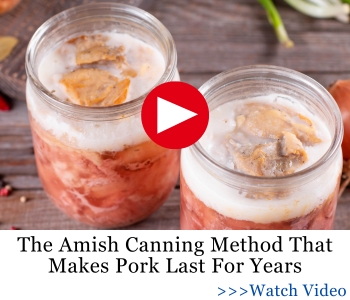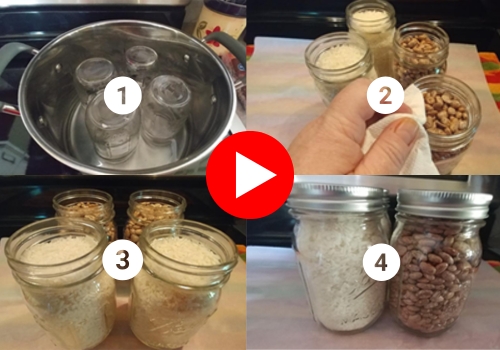The past few years have shown us just how quickly the food supply can shift. Power outages, stalled deliveries, rising prices – suddenly, those grocery store shelves aren’t as reliable as we thought. True food security starts at home.
Most supermarket items aren’t built to last, but there are certain old-school staples that can stay good for decades. These are the same foods our grandparents counted on, and they’re exactly what every prepper should have stocked in their pantry.
White Rice, the Best Grain for Long-Term Storage
White rice earns its place in every serious prepper’s pantry because it just works! It’s high in calories, easy to store, and proven to last decades when sealed properly.
 When sealed and stored correctly, polished white rice can stay good for 25 to 30 years, according to Utah State University.
When sealed and stored correctly, polished white rice can stay good for 25 to 30 years, according to Utah State University.
Rice is also versatile, and you can use it as a base for a variety of dishes, including beans, stews, soups, and even breakfast meals. Even though brown rice is higher in nutrients, it contains oils that make it spoil faster. Thus, white rice is the better long-term choice.
For long-term storage, it’s advisable to store it in airtight, moisture-proof containers and keep them in a cool, dry place.
Dried Beans, Peas, and Lentils
Beans have always been an experienced prepper’s favorite, because they are a great source of protein, fiber, and minerals. As you all know, these important nutrients keep you going when fresh food isn’t an option.
Moreover, other legumes such as peas and lentils are another essential pantry staple. And all you have to do is keep them dry and sealed! They will be safe to consume for well over 20 years if you store them correctly. Once again, airtight containers are the solution! As for how you can prep some nutrient-dense dishes, you can pair beans with rice, and you’ve got a complete protein source. In an emergency, this combination can literally save your life.
Nevertheless, rice, beans, peas, and even your favorite canned foods won’t last long if you don’t know a few key things about how to store and protect them properly. You might think you’ve got it all figured out, but without the right guidance, your carefully stocked pantry could spoil faster than you realize.
In this case, it’s worth learning how to turn your pantry into a true survival system. It’s not enough to simply stockpile beans, sugar, and flour. You also need to know how to preserve them, keep pests away, and set up a rotation calendar so nothing goes bad or makes you sick.
On top of that, proper temperature control and storage techniques – the kind professionals use, can make all the difference in keeping your supplies safe and ready when you need them most.
Canned Meats, Fish, and Vegetables
When the freezer stops working or the store shelves run low, canned foods keep you covered thanks to the sealing process that keeps air and bacteria out.
If you want to play it smart, which you should be doing, keep a mix of canned meats like tuna, salmon, chicken, and beef. They give you protein that’s ready to eat cold if cooking isn’t an option. Add canned vegetables or beans, and you can put together a solid meal in minutes.
But, before you tuck any cans away, give each one a good look. Rust, bulging lids, or nasty dents? Toss it or else you’ll regret it. Otherwise, if it’s clean and sealed, it could outlast almost everything else in your pantry.
Powdered Milk and Powdered Eggs
Powdered milk and eggs are easy to use, take up little space, and last for years when sealed and stored in a cool, dry location.
You can use powdered milk for drinks, baking, or cooking, while powdered eggs are great for making scrambled eggs, pancakes, or baked meals. Both add important nutrients that you might miss during long emergencies, so don’t skip them when shopping for pantry items.
Related: How To Make Powdered Eggs
Keep them in airtight containers away from light. If you store them right, they’ll stay good for up to ten years and help you keep your meals varied.
Sugar and Salt
Sugar and salt may seem basic, and they are, but they do a lot of heavy lifting, so don’t forget about them! They add flavor, preserve food, and can make meals more interesting when they become repetitive. As for shelf life, white sugar lasts indefinitely if stored in a dry place. It might clump, but that doesn’t affect the quality. Salt also keeps forever and is useful for curing meat or preserving vegetables.
As you’ve probably noticed from all the items we discussed so far, moisture is the only real threat. If you store pantry items in sealed containers, you’ll never have to worry about running out.
Wheat Berries and Flour
Whole wheat berries are one of the best long-term foods you can store. Kept sealed and dry, they can last for 30 years or more. When you grind them, you get fresh flour for bread, pancakes, and other baked foods. Flour itself doesn’t last as long, so it’s smart to store both and rotate regularly. Owning a small hand mill is a great idea. It gives you independence and fresh flour whenever you want it.
Oats and Other Whole Grains
 Stored in airtight containers, oats can stay fresh for more than ten years. Grains like barley, rye, and millet also keep well and work in numerous recipes. Whole grains make a solid breakfast or a hearty base for soups and stews.
Stored in airtight containers, oats can stay fresh for more than ten years. Grains like barley, rye, and millet also keep well and work in numerous recipes. Whole grains make a solid breakfast or a hearty base for soups and stews.
Packed with fiber and protein, they’re a reliable nutritional powerhouse when fresh food isn’t available. Keep them dry and protected from pests, and you’ll always have a dependable stash ready.
Freeze-Dried and Dehydrated Fruits and Vegetables
Having fruits and vegetables that last for decades might sound impossible, but freeze-drying makes it real. This process removes almost all moisture, keeping flavor and nutrients intact for up to 30 years.
⇒ 27 Items to Get Before It’s Too Late (They’ll Become the NEW Money)
Dehydrated foods are another good option. They’re easier to make at home, though they don’t last quite as long. Both help round out your diet and add color and variety to your stored meals. Keep them sealed and out of the light. They’ll be ready to rehydrate whenever you need them.
Peanut Butter and Other Nut Butters
Few foods deliver as much comfort and energy as peanut butter. This beloved pantry item is packed with protein, calories, and healthy fats. When you can get all that in one jar, you can’t skip it! Unopened peanut butter usually keeps for around two years. Cooler storage can stretch that time even further. Stick with commercial brands for long-term storage, since natural ones can separate and spoil faster.
Honey, the timeless superfood
When it comes to shelf-life, honey is nothing short of a miracle. Archaeologists have discovered jars of it in ancient Egyptian tombs that were still perfectly edible after thousands of years. That’s because honey’s low moisture and high acidity make it naturally resistant to bacteria and mold.
You can use honey as an energy source, a natural preservative, a natural sweetener, and even as a first-aid item for wounds or sore throats. Simply put, honey is not a maybe, but a definite must!
One of the long-term effects of honey storage is that it might crystallize. However, crystallization doesn’t mean the honey is spoiled. All you have to do is to warm it gently, and it will return to liquid form. To preserve its healing properties and unique taste, store it in sealed glass jars away from direct sunlight. This way, it will outlast almost every other item in your pantry.
 If you’re looking for some low-cost, honey-based recipes that go beyond the usual teas and tonics, check out Forgotten Home Apothecary.
If you’re looking for some low-cost, honey-based recipes that go beyond the usual teas and tonics, check out Forgotten Home Apothecary.
This book is a great place to start, because you have the opportunity to learn how to use honey in creative, low-cost ways, preserve your ingredients so your remedies last longer, and turn everyday pantry items into powerful tools for health.
Whether you’re a beginner or just curious about traditional apothecary practices, this guide gives you everything you need to make natural wellness part of your daily routine!
Shelf-Stable Fats and Oils
If you love good food like I do, you sure know that without fats, food feels empty and unsatisfying. Therefore, when it comes to stockpiling oils, the trick is choosing fats that won’t spoil quickly. Coconut oil, ghee, and canned shortening hold up well for several years if you store them cool and sealed, of course. Also, don’t forget to rotate your fats every year or two, and you’ll never have to worry about running out of cooking oils when supplies run short.
Storing Tips For Lasting Foods
 Even the longest-lasting foods won’t do you any good if they’re stored carelessly. It doesn’t matter if you’ve got a 25-year freeze-dried stash, if it’s sitting in a damp, warm corner, it’s as good as trash. The basics still matter: keep your food in a cool, dry, dark place.
Even the longest-lasting foods won’t do you any good if they’re stored carelessly. It doesn’t matter if you’ve got a 25-year freeze-dried stash, if it’s sitting in a damp, warm corner, it’s as good as trash. The basics still matter: keep your food in a cool, dry, dark place.
So, if you want to keep your stockpile food fresh for longer, Easy Cellar is what you need.
This comprehensive guide shows you exactly how to build the food preservation system that keeps your stockpile fresh for years. It’s is the simplest way to upgrade your survival plan, and even a small space can make a monumental difference.
Here are a few useful advice prepper should apply to every item in the pantry:
- Seal it tight, or lose it fast. Air and moisture are sneaky destroyers. Even a tiny leak in a Mylar bag or a poorly closed mason jar can ruin weeks or months of prep work. Invest in vacuum sealers, oxygen absorbers, and airtight containers. Don’t just “close the lid”; think like a survivalist who can’t afford to replace that food.
- Label and rotate religiously. Write the purchase or pack date on every container. Use older items first and move new stock to the back. Forgetting this step is the fastest way to end up with a pantry full of “vintage” cans that are no longer edible.
- Inspect like clockwork. Check your stock at least once or twice a year and make sure you look for bulging cans, moisture in bags, broken seals, or even pests that snuck in.
- Keep humidity under control. Silica gel or food-safe desiccant packs can save your grains and powdered goods from turning into clumps of mold.
- Avoid storing food directly on concrete floors; it draws in moisture. Use pallets, shelves, or anything that raises the stash a few inches off the ground.
- Don’t underestimate temperature control. Even a cool basement can get warm in summer – think insulated bins or climate-controlled storage if you’re serious.
Final Thoughts
Long-lasting foods mean freedom! When you store smart and stay organized, you’re not at the mercy of broken supply chains or empty stores. Start with simple staples and build up over time. The foods on this list are proven to last and are easy to use. When life gets unpredictable, your pantry won’t be!
Which long-lasting food surprised you the most in a real survival test? Share your experience below!
You may also like:
 Canning Mormon Beans For Long Term Preservation
Canning Mormon Beans For Long Term Preservation
Signs Your Neighbor Will Become a Looter as Soon as SHTF (VIDEO)
Foods You’ve Been Storing Wrong Your Whole Life


















